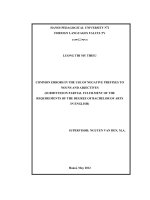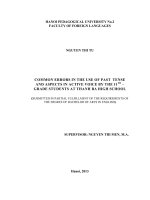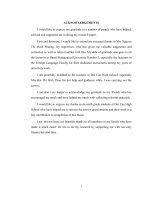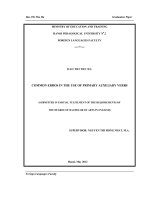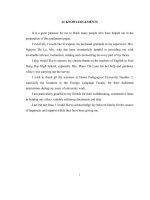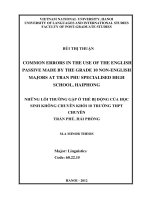Common errors in the use of English articles made by first-year students at Hung Yen industrial college = Những lỗi phổ biến trong sử dụng mạo từ tiếng Anh của
Bạn đang xem bản rút gọn của tài liệu. Xem và tải ngay bản đầy đủ của tài liệu tại đây (1.39 MB, 53 trang )
iii
ABSTRACT
This study focuses on the analysis of errors in the use of English articles made by
first-year students at Hung Yen Industrial College with an aim to recommend some
selected implications for better teaching of English articles. The analysis was based
on the data collected from two tests: a free-response test, writing a composition and
a multichoice test provided by 90 non-major first-year students of Hung Yen
Industrial college. Errors were described and classified according to linguistic
category and strategies employed by the students. The greatest frequency of errors
occured in the definite article in both tests. The omissions of both definite and
indefinite articles were most found in the compositions but the wrong selections of
definite article instead of the indefinite in the multi-choice test. Explanations for the
causes of the errors were done: interlingual or intralingual and developmental
causes. Suggestions for improvement in teaching English articles are offered based
on the findings.
iv
LIST OF ABBREVIATIONS AND SYMBOLS
E.g.
For example
i.e.
That is
L1
First language
L2
Second language
EFL
English as a foreign language
Ø
Zero article
v
LIST OF TABLES
Table 1: Summary of English articles (p.5)
Table 2: Bickerton’s semantic table for noun phrase reference (p.9)
Table 3: General information of the writing corpus (p.25)
Table 4: Frequencies of articles supplied in the written work by article type (26)
Table 5: Non-pass and pass students of Test 2 (p.26)
Table 6: Distribution of choices by the students in Test 2 (p.27)
Table 7: Distribution of explanations on the right choices by the students in Task 1
(p.27)
Table 8: Errors classified according to linguistic categories (p.29)
Table 9: Errors classified according to the strategies employed by the students
(p.30)
Table 10: Strategies and causes of errors (p.36)
Table 11: Interlingual versus intralingual and developmental errors (p.37)
vi
TABLE OF CONTENTS
DECLARATION OF ORIGINALITY i
ACKNOWLEDGEMENTS ii
ABSTRACT iii
LIST OF ABBREVIATIONS AND SYMBOLS iv
LIST OF TABLES v
TABLE OF CONTENTS vi
PART A: INTRODUCTION
1. Rationale for the study 1
2. Aims of the study 2
3. Research questions 2
4. Scope of the study 2
5. Methods of the study 3
6. Significance of the study 3
7. Design of the study 3
PART B: DEVELOPMENT
CHAPTER 1: LITERATURE REVIEW
1.1. An overview of English article system 4
1.1.1. Definitions of English article 4
1.1.2. Types of English articles 4
1.1.2.1. Definite article 5
1.1.2.2. Indefinite articles 6
1.1.2.3. Zero article 7
1.1.3. Usage of English articles 8
1.2. The determiners in Vietnamese language 10
1.3. Error and error analysis 12
1.3.1. The notions of errors in language learning 12
1.3.2. Classifications of errors 13
1.3.3. Error analysis 14
vii
1.3.3.1. Definitions 14
1.3.3.2. Significance of error analysis 15
1.3.3.3. Stages in error analysis 16
1.4. Causes of errors in second language learning 17
1.4.1. Causes of interlingual errors 17
1.4.2. Causes of intralingual and developmental errors 18
CHAPTER 2: RESEARCH METHODOLOGY
2.1. Setting of the study 21
2.2. Participants 22
2.3. Instruments of data collection 23
2.4. Data collection procedures 23
2.5. Methods of data analysis 24
CHAPTER 3: FINDINGS, DISCUSSIONS AND RECOMMENDATIONS
3.1. Findings and discussions 25
3.1.1. General evaluation of the students’ performance 25
3.1.2. Recognition of errors 28
3.1.3. Description of errors 28
3.1.4. Explanation of errors 31
3.2. Recommendations 37
3.2.1. Recommendations for instructional materials 37
3.2.2. Recommendations for teachers’ presentation 38
PART C: CONCLUSION
1. Conclusions 40
2. Limitations and suggestions for further study 41
REFERENCES 42
APPENDIX VIII
MULTI-CHOICE TEST VIII
-1-
PART A: INTRODUCTION
1. RATIONALE FOR THE STUDY
The English article system is one of the most difficult aspects of English grammar for
students of English as a second language to understand. English articles occur very
frequently and incorrect use may affect communication negatively. Also an L2 writer
may prefer to be accurate, when he/she has to write. Master (2002) attributes this
difficulty to three facts about the article system: First, the English articles, the, a and
zero, are the most commonly used words in English, making constant rule application
difficult over a long discourse; Second, function words are often spoken with such
weak stress that they are inaudible and consequently are very difficult for non-native
speakers to discern, which affects the availability of input in the spoken mode; and
third, the article system stacks multiple functions onto a single morpheme, which
constitutes a considerable burden for the learner who usually looks for a one-to-one
correspondence between form and function, especially in the early stages of language
learning.
In addition, because they rarely carry significant information, they can usually be
deleted in telegraphic speech, including telegrams and newspaper headlines. Thus,
unlike content words, function words are generally overlooked by learners when
processing language primarily for meaning. According to Pienemann (1998), the
difficulty of the meaning expressed by an article is determined by the novelty and
abstractness of the concept, not to mention learners’ changing hypotheses about article
usage at different stages in interlanguage development and the potential influence of
the native language which may further complicate the task.
The idea of doing my research came from the following reasons. First, researchers such
as Newman (1977, cited in Master, 1988) and Barry Lush (2002) analyzed the
composition errors of EFL learners and found that of all error types, the most common
were related to definite and indefinite articles.
-2-
Second, the English article system is so difficult to acquire for students with article-less
languages like Vietnamese as their first language. It is also understood that these errors
are mostly caused by the fact that no such independent grammatical category as the
article exists in Vietnamese on which the learners could lean when learning the use of
the English article system. This, of course, holds true generally, but we still come up
against the problem of which parts of the English article system are especially difficult
for Vietnamese learners to understand and learn.
2. AIMS OF THE STUDY
This study is carried out with the aims:
To identify the students’ common types of error in using English articles.
To find out the causes of error committed by Hung Yen Industrial College’s
students when learning and using English articles.
To work out possible solutions to the problems identified.
3. RESEARCH QUESTIONS
In order to achieve the above mentioned aims, the study will be conducted to answer
the three following research questions:
1) What are the common types of article errors made by first-year students at
Hung Yen Industrial College?
2) What are the possible causes of the errors the students make in the use of
English articles?
3) What are the recommendations for the teachers to teach English articles
effectively?
4. SCOPE OF THE STUDY
The research will deal with errors in the use of English articles on the first-year student
writings at Hung Yen Industrial College. The subjects selected for this study are 90
general EFL learners.
-3-
5. METHODS OF THE STUDY
In order to complete the paper, the main research methods employed are:
- Statistical methods are used to find out and classify the learners’ errors
- Descriptive methods are used to describe the actual errors committed by the
learners
6. SIGNIFICANCE OF THE STUDY
The study will be useful not only to the author and her colleagues in improving the
teaching quality, but students will also benefit from it. The result of the study will serve
as a foundation for the possible solutions to students’ errors in using English articles.
Furthermore, the study will make some contribution to the field of teaching
methodology.
7. DESIGN OF THE STUDY
The study has three main parts as follows: Part A provides a brief introduction to the
issue and an overview of the paper. Part B includes three chapters, namely Literature
Review (Chapter 1), Research Methodology (Chapter 2) and Data Analysis and
Discussion (Chapter 3). In greater details, Chapter 1 reviews the theoretical
backgrounds to English article system, error and error analysis in second language
learning. Chapter 2 describes the methods used to carry out the study. It also includes
an overview of the context of the study. Chapter 3 presents and analyzes the data
collected, and offers possible solutions to errors made by students at Hung Yen
Industrial College. Some suggestions for the betterment of teaching and learning
English article system are also provided. Part C summarizes the main issues so far
touched upon in the research, the limitations of the research and some suggestions for
further studies. Following the chapters are the references and one appendix.
-4-
PART B: DEVELOPMENT
CHAPTER 1: LITERATURE REVIEW
1.1. An overview of English article system
The article in English has always been considered one of the most formidable problems to
overcome in teaching English grammar to foreigners and its misuse is one of the most
evident grammatical signs that a person is not a native speaker of English. In this part, I
will present an overview of English article system.
1.1.1. Definitions of English article
An important subset of adjectives in English is the determiner, a category of words that
indicate which noun is being discussed. The determiner in English consists of articles (a/an,
the), possessives (my, your, their, etc), demonstratives (this, that ), numerals (three,
first…) and a few quantifiers (some, many…).
According to Richards and Schmidt (2002), determiner is a word which is used with a
noun and which limits the meaning of the noun in some way. The most common kind of
determiner in English is the article. And Alexander (1998) defines that “articles are
determiners which affect the meaning of the noun, and make it clearer by showing which
particular thing we are referring to” (p.55).
1.1.2. Types of English articles
In Thomson and Martinet (1986:15-22), English articles are classified into two types:
definite article the and indefinite article a/an. However, Quirk and Greenbaum (1987) adds
one more type, that is zero article Ø. Yotsukura (1970) seems to be the first person who
suggests adding another category beside the zero article. So English articles include a/an, the
and Ø (the null or zero marker). The two categories of the article are traditionally called
indefinite and definite articles. Singular count nouns take a or an as indefinite articles.
Plural nouns and non-count nouns take as their indefinite article. All categories of nouns
take the as the definite marker. This system is summarized in the following table:
-5-
INDEFINITE ARTICLE
DEFINITE ARTICLE
Count noun
Singular
a/ an
The
Plural
Ø
The
Non-count noun
Ø
The
Table 1: Summary of English articles
According to Whitman (1974), “thinking about the articles in such terms as: A/an is the
indefinite article and the is the definite article” (p.253) is considered a misunderstanding or
misconception. He also explains that
The misconception involved lies in thinking that a/an and the are essentially the
same thing (that is, “articles”), differing only along a dimension of “definiteness/
indefiniteness” or “specificity/ nonspecificity”. A/an and the are, in fact, entirely
different syntactic entities, quite unrelated to each other except for that fact that
both occur within the same general structure (p254).
However, for reasons of conformity with other grammarians and textbooks, the
terminology “indefinite” or “definite” will be kept. For example, if we say, ‘I have a book
you may be interested in,” we are referring to a definite, specific book. Nonetheless, we
use the indefinite article a to signal that the book is not known by the listener.
1.1.2.1. Definite article
“The definite article the never varies in form whether it refers to people or things, singular
or plural” (Alexander, 1998:55).
(1) a. Ann is in the garden. (the garden of this house)
b. Please pass the wine. (the wine on the table)
(Thomson and Martinet, 1998:19)
According to Halliday and Hasan,
The definite article has no content. It merely indicates that the item in
question is specific and identifiable; that somewhere the information
necessary for identifying it is recoverable (1976:71).
-6-
The definite article indicates a referent that familiar in the general knowledge shared by the
speaker and the listener (s), whilst the zero article refers to something generic. The generic use
of the noun leaves out the definite article.
(2) a. I don’t like surprises.
b. The surprises they had were fantastic.
In the example above, the noun surprises in the first sentence is referring to generic
surprises as the speaker does not designate what kind of surprises. Consequently, the noun
surprises does not involve a definite article the. In the second sentence, the noun surprises
is referring to specific ‘surprises”. Thus, the noun does require a definite article.
1.1.2.2. Indefinite articles
Quirk et al. (1985:272) give this definition:
The indefinite article is notionally the “unmarked” article in the sense that it is used (for
singular count nouns) where the conditions for the use of the do not obtain. That is, a/an X
will be used where the reference of X is not uniquely identifiable in the shared knowledge
of speaker and hearer.
The indefinite article (a/an) occurs in an indefinite singular noun phrase environment to
denote the countability of the noun phrase. This special syntactic distribution of a, however,
signals an important conceptual meaning such as individuating or particularising. The basic
core function of a can be stated as: to introduce a single indefinite, individuated entity to
the wider general set of entities denoted by the head noun. The use of a indicates that there
must exist other referents of the same general set that are not included in the particular act
of reference. This function is often called its instantial use or specimen of a category use.
(3) a. I need a visa
b. A car must be insured. (Thomson and Martinet, 1998:15)
A more process-oriented definition is that “the indefinite article acts as an instruction to the
listener not to bother to search for that referent-for a variety of reasons” (Gallaway, 1987,
cited in Beaumont and Gallaway, 1994:163).
-7-
1.1.2.3. Zero article
Although the term “zero article” traditionally refers to any instance in which a noun
requires no article, the researchers (Yotsukura, 1970; Celce-Murcia & Larsen-Freeman,
1999) divide the zero article into two types: zero and null. To Yotsukura, there is
distributional evidence suggesting a form other than the zero article. By using a post-
modifying restrictive relative clause test, she discovered that the second zero form is found
before singular proper nouns and some common nouns. Celce-Murcia & Larsen-Freeman
also found that the zero article occurs with nonspecific or generic noncount and plural
nouns, such as water and cats. The null article occurs with certain singular count and
proper nouns, such as Chicago and lunch. Quirk et al. (1985: 246) describe a proper noun
like Marjon as having “no article” and a common noun like music as having a “zero
article”.
Chesterman suggests using the term the null form for the second zero article. Let us
consider examples such as the following from Chesterman (1991:17).
(4) a. * I like London that the tourists see.
b. I like the London that the tourists see.
c. I like cheese that is made of goat’s milk.
(5) a. Word has come that the Pope has died.
b. *Word that came yesterday was that the Pope has died.
c. The word that came yesterday was that the Pope has died.
(6) a. What about question seven?
b. *What about question seven you answered before, then?
c. What about the question seven you answered before, then?
(7) a. Breakfast is ready.
b. *Breakfast you asked for is ready.
c. The breakfast you asked for is ready.
Through a post-modifying restrictive clause test, it can be seen that there is a difference
between a proper noun such as London (with a presumed null article) and a common noun
such as cheese (with a presumed zero article). A noun with a zero article can be used with a
restrictive clause, but a noun with the null form cannot. In order to ‘identify’ the proper
nouns in (4b), (5c), (6c), and (7c), the should be used instead. Master (1997) supports
-8-
Chesterman when he regards the null form as the null article. To him, the null article is the
most definite of the articles.
1.1.3. Usage of English articles
“Articles are the most commonly used words in English, and yet their usage is in fact
surprisingly complex. Part of the complexity can be attributed to the fact that the English
article system does not consist of one-to-one form and meaning relationships. This
complexity poses a number of challenges for L2 learners of English” (Andersen 1984,
cited in Butler, 2002:452).
Hok, R. (1970) summarizes the rules for using the article as follows:
“1. Count nouns in the singular must use the or a.
2. Non-count nouns and plural count nouns may use the or Ø.
3. The choice between the, a, Ø depends on the speaker’s position (i.e., the
category he is working from)” (p.234).
The English article system has long been a subject of interest for linguists, given its
complex usage and the difficulty involved in analyzing it. According to Bickerton (1981,
cited in Liu & Gleason, 2002),
The use of the English articles—a, the, and zero—is governed by the semantic
function of the noun phrase (NP) in discourse. The classification of the semantic
function of an NP is then determined, he argued, by two binary discourse features: (a)
whether a noun is a specific referent (±SR), and (b) whether the hearer knows the
referent (±HK). Based on such an analysis, NPs fall into four major semantic types
(p.2).
The classification is summarized in the following table
